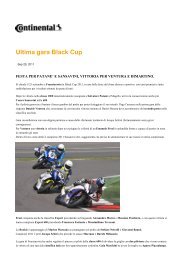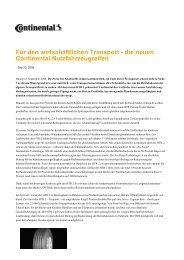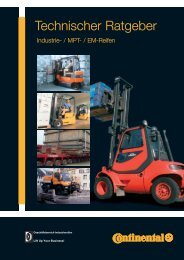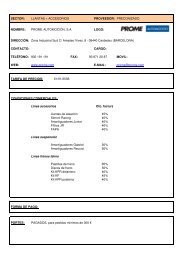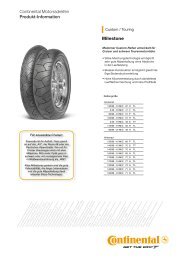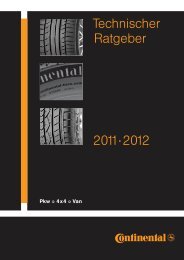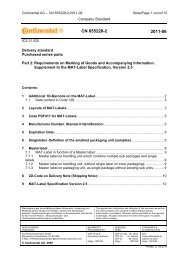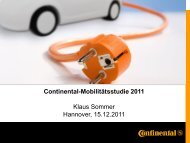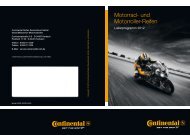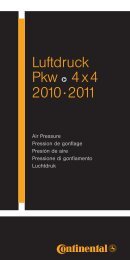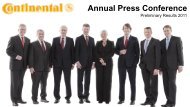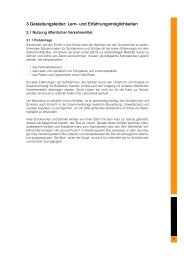Truck, bus and coach tyres Basics to optimize your tyre performance
Truck, bus and coach tyres Basics to optimize your tyre performance
Truck, bus and coach tyres Basics to optimize your tyre performance
You also want an ePaper? Increase the reach of your titles
YUMPU automatically turns print PDFs into web optimized ePapers that Google loves.
<strong>Truck</strong>, <strong>bus</strong> <strong>and</strong> <strong>coach</strong> <strong><strong>tyre</strong>s</strong><br />
<strong>Basics</strong> <strong>to</strong> <strong>optimize</strong> <strong>your</strong><br />
<strong>tyre</strong> <strong>performance</strong>
2<br />
<strong>Basics</strong> <strong>to</strong> <strong>optimize</strong> <strong>your</strong> <strong>tyre</strong> <strong>performance</strong><br />
Publisher’s imprint<br />
The content of this publication is provided for information only<br />
<strong>and</strong> without responsibility. Continental Reifen GmbH Deutschl<strong>and</strong><br />
makes no represen tations about the accuracy, reliability,<br />
completeness or timeliness of the information in this publication.<br />
Continental Reifen GmbH Deutschl<strong>and</strong> may, in its sole discretion,<br />
revise the information contained herein at any time without<br />
notice.<br />
Continental Reifen GmbH Deutschl<strong>and</strong>’s obligations <strong>and</strong> responsibilities<br />
regarding its products are governed solely by the agreements<br />
under which they are sold. Unless otherwise agreed in<br />
writing, the informa tion contained herein does not become part<br />
of these agreements. This publication does not contain any guarantee<br />
or agreed quality of Continental Reifen GmbH Deutschl<strong>and</strong>’s<br />
products or any warranty of merchant ability, fitness for a<br />
particular purpose <strong>and</strong> noninfringement.<br />
Continental Reifen GmbH Deutschl<strong>and</strong> may make changes in the<br />
products or services described at any time without notice.<br />
This publication is provided on an “as is” basis. To the extent permitted<br />
by law, Continental Reifen GmbH Deutschl<strong>and</strong> makes no<br />
warranty, express or implied, <strong>and</strong> assumes no liability in connection<br />
with the use of the information contained in this publication.<br />
Continental Reifen GmbH Deutschl<strong>and</strong> is not liable for any direct,<br />
indirect, incidental, consequential or punitive damages arising<br />
out of the use of this publication. Information contained herein is<br />
not intended <strong>to</strong> announce product availability anywhere in the<br />
world.<br />
The trademarks, service marks <strong>and</strong> logos (the Trademarks) displayed<br />
in this publication are the property of Continental Reifen<br />
GmbH Deutschl<strong>and</strong>. Nothing in this publication should be construed<br />
as granting any license or right <strong>to</strong> the Trademarks. Without<br />
the express written consent of Continental Reifen GmbH Deutschl<strong>and</strong><br />
the use of the Trademarks is prohibited.<br />
All text, images, graphics <strong>and</strong> other materials in this publication<br />
are subject <strong>to</strong> the copyright <strong>and</strong> other intellectual property rights<br />
of Continental Reifen GmbH Deutschl<strong>and</strong>. Continental Reifen<br />
GmbH Deutschl<strong>and</strong> owns the copyrights in the selection, coordination<br />
<strong>and</strong> arrangement of the materials in this publication. These<br />
materials may not be modified or copied for commercial use or<br />
distribution.<br />
Copyright © 2010 Continental Reifen GmbH Deutschl<strong>and</strong><br />
All rights reserved<br />
Contents<br />
<strong>Truck</strong> <strong><strong>tyre</strong>s</strong> – technical basics ......................................................................... 4<br />
From the very beginning .................................................................................. 4<br />
Today more than ever: <strong><strong>tyre</strong>s</strong> <strong>optimize</strong>d for specific uses ................................. 6<br />
Global <strong>tyre</strong> development ................................................................................. 8<br />
<strong>Truck</strong> <strong>tyre</strong> components <strong>and</strong> their functions ..................................................... 10<br />
Tyre production ............................................................................................... 12<br />
Legal <strong>and</strong> st<strong>and</strong>ardized markings used on the <strong>tyre</strong> sidewall ........................... 14<br />
Units of measurement <strong>and</strong> definitions ............................................................. 16<br />
Unlock <strong>your</strong> truck <strong>tyre</strong>’s potential – retreading <strong>and</strong> regrooving .......................<br />
Maintenance <strong>and</strong> care of truck <strong><strong>tyre</strong>s</strong> –<br />
repair, inflation, tread depth <strong>and</strong> s<strong>to</strong>rage ......................................................... 22<br />
Damage <strong>to</strong> truck, <strong>bus</strong> <strong>and</strong> <strong>coach</strong> <strong><strong>tyre</strong>s</strong> caused by external fac<strong>to</strong>rs ................. 26<br />
Tread ............................................................................................................... 28<br />
Sidewall ........................................................................................................... 34<br />
Bead ................................................................................................................ 38<br />
18<br />
Contents<br />
3
<strong>Basics</strong> <strong>to</strong> <strong>optimize</strong> <strong>your</strong> <strong>tyre</strong> <strong>performance</strong><br />
<strong>Truck</strong> <strong><strong>tyre</strong>s</strong> – technical basics<br />
From the very beginning<br />
We’ve been partners of the transportation industry ever since <strong><strong>tyre</strong>s</strong> have<br />
been around. We’ve set technological miles<strong>to</strong>nes <strong>and</strong> furthered the development<br />
of our products. As a company, we’ve grown at an amazing pace. But<br />
one thing has always stayed the same: The needs of our cus<strong>to</strong>mers set the<br />
st<strong>and</strong>ard for everything we do.<br />
The Continental s<strong>to</strong>ry is a success s<strong>to</strong>ry in German<br />
engineering. From the very beginning our company has<br />
been interwoven with the transportation industry. The<br />
result is a broad range of innovations – such as the<br />
tubeless <strong>tyre</strong> – <strong>and</strong> a full line of products tailored <strong>to</strong><br />
meet the needs of various sec<strong>to</strong>rs within the transportation<br />
<strong>bus</strong>iness.<br />
But all that is possible only because we have always<br />
based the development of our products on a simple,<br />
yet dem<strong>and</strong>ing st<strong>and</strong>ard: The needs of our cus<strong>to</strong>mers.<br />
And because these needs are as different as the various<br />
sec<strong>to</strong>rs of the transportation industry themselves,<br />
we still look at things first through the eyes of our<br />
cus<strong>to</strong>mers . . .<br />
• In the 1950s • In the Continental 1950s • In the Continental 1950s already Continental offers already specialized offers already specialized offers tires for specialized different tires for tires different types for of different types of types of<br />
trucks <strong>and</strong> trucks for <strong>bus</strong>es <strong>and</strong> trucks for <strong>and</strong> <strong>bus</strong>es <strong>and</strong> communicates for <strong>and</strong> <strong>bus</strong>es communicates <strong>and</strong> segment-specifi communicates segment-specifi c segment-specifi benefi ts. c benefi c ts. benefi ts.<br />
<strong>Truck</strong>s <strong>Truck</strong>s <strong>Truck</strong>s Buses Buses Buses Construction Construction VehiclesConstruction<br />
Vehicles Vehicles<br />
As early as the 1950s, Continental was already offering specialized <strong><strong>tyre</strong>s</strong><br />
for various kinds of trucks <strong>and</strong> <strong>bus</strong>es – <strong>and</strong> tailoring its communication<br />
1870s – 1910s 1870s – 1920s 1910s 1870s – 1920s 1910s 1930s 1920s 1930s 1940s 1930s 1940s 1950s 1940s 1950s 1960s 1950s 1970s 1960s– 1980s 1960s 1970s 1990s – 1980s – <strong>to</strong>day 1970s 1990s – 1980s – <strong>to</strong>day 1990s – <strong>to</strong>day<br />
of • • Segment-specific specific • Segment-specific benefits <strong>to</strong> each segment. communication of of of products for for for trucks, <strong>bus</strong>es <strong>and</strong> construction<br />
vehicles continues in in in the 1960s.<br />
/ 19 Tires – Engineered in Tires Germany. – Engineered Tires in – Germany. Engineered in Germany.<br />
08Conti-Br<strong>and</strong>i_RZ12.indd 08Conti-Br<strong>and</strong>i_RZ12.indd 19 19 08Conti-Br<strong>and</strong>i_RZ12.indd 19 30.10.2007 12:33:39 Uhr 30.10.2007 12:33:39 30.10.200 Uhr<br />
In the 1960s, tailored product communication for different segments<br />
continued 1870s – 1910s – – 1910s – trucks, 1910s <strong>bus</strong>es 1920s <strong>and</strong> construction 1930s vehicles. 1940s 1950s 1960s 1970s – 1980s – 1980s – 1980s 1990s – <strong>to</strong>day – <strong>to</strong>day – <strong>to</strong>day<br />
4 5<br />
20 20 20 / 21 / / 21 21<br />
08Conti-Br<strong>and</strong>i_RZ12.indd 20 20 20 30.10.2007 12:33:51 12:33:51 Uhr Uhr Uhr<br />
From the very beginning
<strong>Basics</strong> <strong>to</strong> <strong>optimize</strong> <strong>your</strong> <strong>tyre</strong> <strong>performance</strong><br />
Today more than ever:<br />
Tyres <strong>optimize</strong>d for specific uses<br />
As partners of the global logistics <strong>and</strong> transportation industry, we are deeply<br />
familiar with the various sec<strong>to</strong>rs of this industry. That’s why we know: costefficiency<br />
makes all the difference. Our solution: Tyres <strong>optimize</strong>d for specific<br />
conditions – for every need.<br />
Today, transporters are part of an ever more efficient<br />
global logistics network. As a close companion for our<br />
partners <strong>and</strong> cus<strong>to</strong>mers in the global transport <strong>and</strong><br />
logistics industry, we underst<strong>and</strong> markets as well as we<br />
underst<strong>and</strong> streets <strong>and</strong> roads all over the world. We<br />
also know: The bot<strong>to</strong>m line is costefficiency.<br />
But all streets are not made alike. Nor are various types<br />
of transport. That’s why we have always continued <strong>to</strong><br />
develop our product lines for the cus<strong>to</strong>mer segments<br />
Goods, People <strong>and</strong> Construction. The result? Tyres that<br />
are tailormade for the specific conditions faced by<br />
the various sec<strong>to</strong>rs of the transportation industry. This<br />
leads <strong>to</strong> an increase in the profitability of entire fleets<br />
considerably.<br />
Mo<strong>to</strong>rway<br />
Allround<br />
On/Off<br />
Mo<strong>to</strong>rway<br />
Allround<br />
City<br />
6 7<br />
Allround<br />
On/Off<br />
Off<br />
Goods<br />
People<br />
Construction
8<br />
<strong>Basics</strong> <strong>to</strong> <strong>optimize</strong> <strong>your</strong> <strong>tyre</strong> <strong>performance</strong><br />
Global <strong>tyre</strong> development<br />
Tyre engineering is driven primarily by global<br />
economic development.<br />
This overview shows the main aspects resulting<br />
from this trend.<br />
India China South America/Turkey Europe/NAFTA Europe<br />
Main cus<strong>to</strong>mer needs Load capacity Load capacity/Mileage Mileage/Load capacity Mileage/Fuel savings Fuel savings/Mileage<br />
Main <strong>tyre</strong> characteristics High durability High durability/Optimized mileage<br />
<strong>performance</strong><br />
Optimized mileage <strong>performance</strong>/<br />
High durability<br />
Optimized mileage <strong>performance</strong>/<br />
Rolling resistance optimalization<br />
Rolling resistance optimalization/<br />
Optimized mileage/Low section <strong><strong>tyre</strong>s</strong><br />
Main road characteristics Off On/Off Allround Allround/Mo<strong>to</strong>rway Mo<strong>to</strong>rway/Allround<br />
Main fleet structure Single owners Single owners Cooperations Fleets Fleets<br />
Main <strong>tyre</strong> mounting device Basic <strong>to</strong>ols Basic <strong>to</strong>ols Basic <strong>to</strong>ols/Tyre mounting device Tyre mounting device Tyre mounting device<br />
Main <strong>tyre</strong> type<br />
Main tube type<br />
Main rim type<br />
BIAS <strong>tyre</strong><br />
Tube type <strong>tyre</strong><br />
Typical <strong>tyre</strong> sizes 11.00 – 20<br />
12.00 – 20<br />
inner tube<br />
flap<br />
BIAS <strong>tyre</strong>/Radial <strong>tyre</strong><br />
Tube type <strong>tyre</strong><br />
Radial <strong>tyre</strong><br />
Tube type <strong>tyre</strong>/Tubeless <strong>tyre</strong><br />
Radial <strong>tyre</strong><br />
Tubeless <strong>tyre</strong><br />
multipart multipart multipart/onepart onepart onepart<br />
11.00 – 20<br />
12.00 – 20<br />
11.00 R 20<br />
12.00 R 20<br />
inner tube<br />
flap<br />
11.00 R 20<br />
12.00 R 20<br />
11 R 22.5<br />
12 R 22.5<br />
sealing ring<br />
11 R 22.5<br />
12 R 22.5<br />
315/80 R 22.5<br />
295/80 R 22.5<br />
Radial <strong>tyre</strong><br />
Tubeless <strong>tyre</strong><br />
315/80 R 22.5<br />
295/80 R 22.5<br />
385/65 R 22.5<br />
315/70 R 22.5<br />
315/60 R 22.5<br />
Global <strong>tyre</strong> development<br />
9
10<br />
<strong>Basics</strong> <strong>to</strong> <strong>optimize</strong> <strong>your</strong> <strong>tyre</strong> <strong>performance</strong><br />
<strong>Truck</strong> <strong>tyre</strong> components <strong>and</strong><br />
their functions<br />
4<br />
3<br />
7<br />
6<br />
2<br />
1<br />
5<br />
<strong>Truck</strong> <strong>tyre</strong> components <strong>and</strong> their functions<br />
Component Material Function<br />
1 Tread strip Rubber compound The tread strip must provide high wear resis tance<br />
<strong>and</strong> good grip under all road conditions. Sometimes<br />
the tread strip consists of two different<br />
materials (cap <strong>and</strong> base). In that case, the base<br />
minimizes tread temperature <strong>and</strong> rolling resistance.<br />
2 Multi-ply steel belt Steel cords embedded in<br />
rubber compound<br />
Materials that go in<strong>to</strong> a truck <strong>tyre</strong><br />
Structural components:<br />
core wire (6 %)<br />
nylon fabric (1 %)<br />
steel cord (17 %)<br />
Enhances driving stability, reduces rolling<br />
resistance <strong>and</strong> gives the <strong>tyre</strong> its long service life.<br />
Restricts casing growth <strong>and</strong> increases the <strong>tyre</strong>’s<br />
structural strength.<br />
3 Steel casing Steel cord Gives the <strong>tyre</strong> structural strength <strong>and</strong> de fl ection<br />
characteristics, substantially enhances driving<br />
comfort.<br />
4 Inner liner Rubber compound Prevents diffusion of air <strong>and</strong> moisture in tubeless<br />
<strong><strong>tyre</strong>s</strong>.<br />
5 Sidewall Rubber compound Protects from lateral scuffi ng <strong>and</strong> the effects of<br />
weather.<br />
6 Bead reinforcement Nylon, aramide, steel cord Secures the end of the steel cord ply <strong>to</strong> the<br />
bead core. Reinforces the bead against high<br />
shear forces.<br />
7 Bead core Steel wire embedded in<br />
rubber compound<br />
Ensures fi rm fi t of the <strong>tyre</strong> <strong>to</strong> the rim.<br />
Compound:<br />
natural rubber (30 %)<br />
synthetic rubber (5 %)<br />
halogen butyl rubber (4 %)<br />
other chemicals (37 %)<br />
<strong>Truck</strong> <strong>tyre</strong> components <strong>and</strong> their functions<br />
11
12<br />
<strong>Basics</strong> <strong>to</strong> <strong>optimize</strong> <strong>your</strong> <strong>tyre</strong> <strong>performance</strong><br />
Supplier industry<br />
Various sec<strong>to</strong>rs supply the basic<br />
materials needed <strong>to</strong> manufacture <strong><strong>tyre</strong>s</strong>.<br />
The steel industry supplies high<br />
strength steel cords <strong>and</strong> wires primarily<br />
for the manufacture of steel belts <strong>and</strong><br />
the casing (steel cord) as well as materials<br />
used in the bead cores (steel wire).<br />
steel industry<br />
(steel cord, steel wire)<br />
The chemical industry mostly supplies<br />
synthetic rubber <strong>and</strong> materials that<br />
improve the grip <strong>and</strong> durability of <strong><strong>tyre</strong>s</strong>.<br />
chemical industry<br />
(synthetic rubber, additives)<br />
Natural rubber (latex) is extracted by<br />
tapping rubber trees grown in large<br />
plantations in the tropics.<br />
rubber extraction<br />
(natural rubber)<br />
The textile industry supplies fibers<br />
made of rayon, nylon, polyester etc.<br />
for the manufacture of textile cord,<br />
a reinforcing material, for example<br />
bead reinforcements.<br />
textile industry<br />
(various cords)<br />
Tyre production<br />
Compound production<br />
Natural <strong>and</strong> synthetic rubber are mixed<br />
with additives, following predefined<br />
formulas. Many different rubber compounds,<br />
each <strong>optimize</strong>d for its specific<br />
function, are used in modern <strong><strong>tyre</strong>s</strong>.<br />
rubber portioning<br />
portioning of raw materials<br />
<strong>and</strong> supplies<br />
production of<br />
master batch<br />
making up of production<br />
compound<br />
shaping in<strong>to</strong> transportable<br />
units<br />
Manufacture of semi-finished products<br />
Steel cord Pretreated steel cord is embedded in<strong>to</strong> one or<br />
more layers of rubber on a roller <strong>and</strong> cut <strong>to</strong> the proper length<br />
for the <strong>tyre</strong> size.<br />
steel cord spools steel cord<br />
calendering<br />
cutting steel cord<br />
<strong>to</strong> size<br />
Tread The kneadable mix of materials is formed in<strong>to</strong> an endless<br />
strip by means of a screwlike extruder. The strip is cooled <strong>and</strong><br />
then cut <strong>to</strong> size.<br />
tread extruder<br />
Textile cord Many individual textile threads are fed in<strong>to</strong> the calender<br />
(large roller) via a special winding device <strong>and</strong> are embedded in<br />
a thin layer of rubber. This endless sheet is then cut <strong>to</strong> the desired<br />
width <strong>and</strong> rewound for further processing.<br />
cord fabric on<br />
rollers<br />
Steel bead The core of the <strong>tyre</strong> bead consists of several individual<br />
rubbercoated steel wires formed in<strong>to</strong> rings.<br />
unwinding of<br />
bead wire<br />
Sidewall/Inner liner Sidewall sections cut <strong>to</strong> suit the particular<br />
<strong>tyre</strong> size <strong>and</strong> in various con<strong>to</strong>urs are made with the extruder.<br />
A calender forms the inner liner in<strong>to</strong> a wide, thin layer.<br />
sidewall extrusion<br />
control of weight<br />
per meter<br />
textile cord<br />
calendering<br />
coating of<br />
bead wire<br />
calendering of the<br />
inner liner<br />
tread cooling<br />
cutting textile cord<br />
<strong>to</strong> size<br />
rewinding of<br />
bead wire<br />
cutting the<br />
tread <strong>to</strong> size<br />
control of unit<br />
weight<br />
bead ring applying the apex<br />
Building<br />
All these components come<br />
<strong>to</strong>gether on<strong>to</strong> the <strong>tyre</strong> build ing<br />
machine. They are assem bled<br />
in two stages – casing <strong>and</strong><br />
tread/belt assembly – in<strong>to</strong><br />
what is known as a “green”<br />
<strong>tyre</strong>.<br />
building the<br />
casing<br />
building the tread/<br />
assembling the belt<br />
Vulcanization<br />
Before vulcanizing the<br />
“green” <strong>tyre</strong>, it is sprayed<br />
with a special fluid.<br />
pretreating the<br />
“green” <strong>tyre</strong><br />
The green <strong>tyre</strong> takes its final<br />
form by being vulcanized in<br />
a curing process for a certain<br />
period of time under pres <br />
sure. The raw rubber undergoes<br />
a physical change <strong>and</strong><br />
be comes vulcanized rubber.<br />
The tread pattern <strong>and</strong><br />
sidewall markings of <strong><strong>tyre</strong>s</strong><br />
origi nate in the mold.<br />
Quality control*<br />
After vulcanization the <strong><strong>tyre</strong>s</strong><br />
undergo visual inspection<br />
<strong>and</strong> xraying.<br />
final visual inspection<br />
xray control<br />
Uniformity checks are<br />
performed.<br />
vulcanization check for imbalances<br />
force variation<br />
control<br />
* Each individual stage of production<br />
– from the inspection of the<br />
raw materials through <strong>to</strong> delivery<br />
of the finished <strong>tyre</strong> – is subject <strong>to</strong><br />
ongoing quality control.<br />
Tyre production<br />
13
14<br />
<strong>Basics</strong> <strong>to</strong> <strong>optimize</strong> <strong>your</strong> <strong>tyre</strong> <strong>performance</strong><br />
Legal <strong>and</strong> st<strong>and</strong>ardized markings<br />
used on the <strong>tyre</strong> sidewall<br />
The most important markings<br />
154<br />
e.g. 315/80 R 22.5 156/150 L M tubeless<br />
150<br />
315 <strong>tyre</strong> width in mm<br />
80 crosssectional ratio H : W in %<br />
R radial design<br />
22.5 nominal rim diameter of 15° tapered<br />
rim (code)<br />
4<br />
1<br />
5 10 6 5a 13 9<br />
16<br />
2<br />
8<br />
1a<br />
3<br />
17<br />
11<br />
14<br />
12<br />
15<br />
156 4000 kg <strong>tyre</strong> load capacity S<br />
(single <strong>tyre</strong> fitment)<br />
150 3350 kg <strong>tyre</strong> load capacity D<br />
(dual <strong>tyre</strong> fitment)<br />
L speed 120 km/h (75 mph)<br />
156<br />
( M) alternative permitted operating code<br />
150<br />
tubeless tubeless type<br />
7<br />
Legal <strong>and</strong> st<strong>and</strong>ardized markings<br />
1 Manufacturer<br />
(br<strong>and</strong> name or logo)<br />
1a Tread pattern reference<br />
2 Size designation<br />
315 = <strong>tyre</strong> width in mm<br />
80 = aspect ratio (section height <strong>to</strong><br />
section width) = 80 %<br />
R = radial construction<br />
22.5 = rim diameter (code)<br />
3 Service description consisting of<br />
156 = load index for single fitment<br />
150 = load index for dual fitment<br />
L = code letter for speed rating<br />
4 Country of manufacture<br />
5 Data as per US safety st<strong>and</strong>ard<br />
on inner construction or number of plies,<br />
in this case<br />
tread: under the tread there are five steel cord<br />
plies (including carcass)<br />
sidewall: viewed from the side there is one steel<br />
cord ply (in this case the carcass ply)<br />
5a Load range<br />
in accordance with US st<strong>and</strong>ard<br />
6 US load designation<br />
of single/dual fitment <strong>and</strong> indication of<br />
max. inflation pressure in kg/kPa (lbs/psi)<br />
1 pound (lbs) = 0.4536 kg<br />
1 pound per square inch (psi) = 6.895 kPa<br />
Speed index<br />
Speed in km/h<br />
Speed in mph<br />
Load index<br />
Load capacity (kg/<strong>tyre</strong>)<br />
F<br />
80<br />
50<br />
147<br />
3075<br />
148<br />
3150<br />
G<br />
90<br />
56<br />
149<br />
3250<br />
J<br />
100<br />
62<br />
150<br />
3350<br />
7 TWI (Tread Wear Indica<strong>to</strong>r)<br />
8 Recommended application<br />
only Continental <strong>Truck</strong> Tires<br />
9 Regroovable<br />
the manufacturer has designed the <strong>tyre</strong><br />
for regrooving<br />
10 Tubeless, tube type<br />
11 E = <strong>tyre</strong> complies with value set forth<br />
151<br />
3450<br />
in ECER 54<br />
4 = country code for the country in which<br />
the approval number was issued<br />
(here: 4 = Netherl<strong>and</strong>s)<br />
12 DOT<br />
U. S. Department of Transportation<br />
(responsible for <strong>tyre</strong> safety st<strong>and</strong>ards)<br />
13 M+S<br />
Mud <strong>and</strong> Snow. The manufacturer has designed<br />
the <strong>tyre</strong> for an improved grip/traction <strong>performance</strong><br />
under mud <strong>and</strong> snow conditions.<br />
14 Identification for Brazil<br />
15 Manufacturer code<br />
date of manufacture (week/year)<br />
16 Rotation<br />
recommended direction of rotation<br />
17 Single Point<br />
Alternative load <strong>and</strong> speed<br />
K<br />
110<br />
68<br />
152<br />
3550<br />
L<br />
120<br />
75<br />
153<br />
3650<br />
154<br />
3750<br />
M<br />
130<br />
81<br />
155<br />
3875<br />
N<br />
140<br />
87<br />
156<br />
4000<br />
Legal <strong>and</strong> st<strong>and</strong>ardized markings used on the <strong>tyre</strong> sidewall<br />
15
16<br />
<strong>Basics</strong> <strong>to</strong> <strong>optimize</strong> <strong>your</strong> <strong>tyre</strong> <strong>performance</strong><br />
Units of measurement<br />
<strong>and</strong> definitions<br />
As a matter of principle the technical data in the tables always complies<br />
with the international st<strong>and</strong>ards as specified by ISO <strong>and</strong> the ETRTO. Further<br />
details such as other <strong>tyre</strong> sizes or designs, plus the static radius <strong>and</strong> the<br />
rolling circumference comply with DIN/WdK guidelines.<br />
Lengths<br />
Lengths are given in millimeters.<br />
Rim width<br />
The linear distance between the flanges of the rim.<br />
Section height<br />
Half the difference between the overall diameter <strong>and</strong><br />
the nominal rim diameter.<br />
Tyre width<br />
The section width of an inflated <strong>tyre</strong> mounted on its<br />
theoretical rim <strong>and</strong> indicated in the <strong>tyre</strong> size designation.<br />
Overall diameter<br />
The diameter of an inflated <strong>tyre</strong> at the outermost surface<br />
of the tread.<br />
Nominal diameter<br />
It is a size code figure for reference purposes only, as<br />
indicated in the <strong>tyre</strong> <strong>and</strong> rim size designation.<br />
Tyre pressure<br />
Tyre inflation pressure is given in Bar based on cold <strong>tyre</strong>.<br />
Outer diameter new*<br />
Outer diameter is a nominal size which refers <strong>to</strong> the<br />
tread centre.<br />
* construction size<br />
Max. outer diameter in service<br />
Max. outer diameter in service is the maximum diameter<br />
permitted in the tread center as a result of permanent<br />
growth during <strong>tyre</strong> use. Dynamic deformations are<br />
not included.<br />
Crosssection width new*<br />
Crosssection width is a nominal size referring <strong>to</strong> the<br />
smooth <strong>tyre</strong> wall.<br />
Max. operational width<br />
Max. operational width is the maximum permitted<br />
width. This includes scuff ribs, decorative ribs, lettering<br />
<strong>and</strong> permanent growth during use. Dynamic deformations<br />
are not included.<br />
Static radius<br />
Static radius is the distance from the <strong>tyre</strong> center <strong>to</strong><br />
ground level. Measurements are checked on fitted <strong><strong>tyre</strong>s</strong><br />
inflated <strong>to</strong> the <strong>tyre</strong> pressure specified in DIN 70020<br />
Part 5.<br />
Rolling circumference<br />
Rolling circumference is the distance covered by one<br />
revolution of the <strong>tyre</strong>.<br />
Load capacities<br />
Load capacities are given in kilograms<br />
(weight = mass).<br />
Dual<strong>tyre</strong> spacing<br />
Maintaining the minimum spacing distance ensures<br />
that the two <strong><strong>tyre</strong>s</strong> in a dual fitment arrangement function<br />
without violating ETRTO st<strong>and</strong>ards, provided the<br />
<strong><strong>tyre</strong>s</strong> are not fitted with chains. In the course of<br />
develop ment, a variety of designations for <strong>tyre</strong> dimensions<br />
have been introduced, some of which are used<br />
concurrently.<br />
The following combination is most frequently used:<br />
· Tyre width in mm<br />
· H : W (height : width) in %<br />
· Codes for <strong>tyre</strong> construction (e.g. “R” for radial<br />
<strong>and</strong> “–” for crossply <strong>and</strong> nominal rim diameter<br />
When planning vehicle wheel space, au<strong>to</strong>motive<br />
design ers must proceed on the basis of the maximum<br />
values for <strong>tyre</strong> width <strong>and</strong> outer diameter, taking in<strong>to</strong><br />
account the <strong>tyre</strong>’s static <strong>and</strong> dynamic deformation. In<br />
this way they ensure that all st<strong>and</strong>ardly approved<br />
<strong><strong>tyre</strong>s</strong> will fit in all cases. If this is not possible in<br />
exceptional cases, appropriate measures are <strong>to</strong> be<br />
taken <strong>to</strong> ex clude any possible risk <strong>to</strong> safety.<br />
PR<br />
The ply rating, or PR for short, is an internationally used<br />
st<strong>and</strong>ard for the structural strength of the <strong>tyre</strong> substructure.<br />
The term stems from the time when cot<strong>to</strong>n<br />
was still used for the fabric substructure. In those days<br />
PR actually referred <strong>to</strong> the number of plies. When materials<br />
with greater strength were introduced, the same<br />
structural durability was achieved with fewer plies. PR<br />
now therefore refers <strong>to</strong> a load capacity category <strong>and</strong> is<br />
increasingly being replaces by the load index.<br />
W<br />
<strong>tyre</strong> width<br />
rim width<br />
W <strong>and</strong> Ø new when using the measuring rim<br />
A<br />
r<br />
A = outer diameter on the <strong>tyre</strong><br />
r = static radius<br />
f = deflection under load<br />
M<br />
M = dual-<strong>tyre</strong> spacing<br />
f<br />
rim Ø d H<br />
<strong>tyre</strong> Ø new A<br />
Units of measurement <strong>and</strong> definitions<br />
17
18<br />
<strong>Basics</strong> <strong>to</strong> <strong>optimize</strong> <strong>your</strong> <strong>tyre</strong> <strong>performance</strong><br />
Tread area<br />
Unlock <strong>your</strong> truck <strong>tyre</strong>’s potential –<br />
retreading <strong>and</strong> regrooving<br />
Continental truck <strong><strong>tyre</strong>s</strong> are designed <strong>to</strong> give you maximum economy<br />
through out the entire life of the <strong>tyre</strong> <strong>and</strong> long after that. The following<br />
options show how you can best maximize this potential.<br />
Tyre costs are a substantial fac<strong>to</strong>r in overall operating costs in the transportation<br />
industry. Purchasing a retreaded <strong>tyre</strong> helps <strong>to</strong> reduce this fac<strong>to</strong>r considerably.<br />
The benefits of Continental truck <strong><strong>tyre</strong>s</strong> are not just for one life. Thanks <strong>to</strong> professional<br />
retreading, they can be given a new lease of life <strong>and</strong> deliver the same<br />
quality as a new <strong>tyre</strong>.<br />
In order <strong>to</strong> further extend the service life, a truck <strong>tyre</strong> with the word “regroov able”<br />
on its sidewall can also be regrooved. This option is suitable for fleets which run<br />
their own <strong>tyre</strong> service <strong>and</strong> have a s<strong>to</strong>ck of replacement <strong><strong>tyre</strong>s</strong>. If the company’s<br />
staff have been specially trained in regrooving <strong><strong>tyre</strong>s</strong>, vehicle downtimes can be<br />
<strong>optimize</strong>d.<br />
Unlock <strong>your</strong> truck <strong>tyre</strong>’s potential – retreading <strong>and</strong> regrooving<br />
19
20<br />
<strong>Basics</strong> <strong>to</strong> <strong>optimize</strong> <strong>your</strong> <strong>tyre</strong> <strong>performance</strong><br />
Retreading<br />
Like new. Allround. Continental truck <strong><strong>tyre</strong>s</strong> are certainly well worth the investment.<br />
Their <strong>performance</strong> benefits last not only the en<strong>tyre</strong> life of the <strong>tyre</strong>; they<br />
can also be used a second time around after the Continental retreading process<br />
– all that in the undiminished quality of a new <strong>tyre</strong>, <strong>and</strong> under warranty.<br />
Our ContiRe retreading process gives <strong>your</strong> worn <strong><strong>tyre</strong>s</strong> a new life, maximizing<br />
their economic efficiency.<br />
Production of a ContiRe retread is carried out in the<br />
same way as production of our new <strong><strong>tyre</strong>s</strong>. We use ultramodern<br />
inspection techniques <strong>and</strong> latest manufacturing<br />
methods <strong>to</strong> guarantee a consistently high level of<br />
product quality. A st<strong>and</strong>ardized quality system with<br />
endur ance <strong>and</strong> safety testing ensures that ContiRe retreads<br />
meet superior quality st<strong>and</strong>ards. Not only are<br />
our ma n ufacturing methods, quality systems <strong>and</strong> inspection<br />
techniques comparable <strong>to</strong> those used in the<br />
production of new <strong><strong>tyre</strong>s</strong>; we even use the same tread<br />
patterns <strong>and</strong> compounds. And of course, we only use<br />
carefully inspected, perfect casings with the C2 casing<br />
guarantee for our ContiRe retreads. Indeed, there is no<br />
question that the product characteristics of a ContiRe<br />
retread fully comply with those of our new <strong><strong>tyre</strong>s</strong>.<br />
Continental casings incorporate firstclass quality <strong>and</strong><br />
technological sophistication, making them an extremely<br />
valuable raw material – <strong>and</strong> indeed it is the casing<br />
that forms the basis for retreading. By purchasing a<br />
retread, you are not only easing <strong>your</strong> <strong>tyre</strong> budget, but<br />
also making an active contribution <strong>to</strong>wards protecting<br />
the environment. Reusing the casing helps save energy<br />
<strong>and</strong> raw materials. What’s more, maximum utilization of<br />
<strong>tyre</strong> casings means you are helping <strong>to</strong> reduce the number<br />
of scrap <strong><strong>tyre</strong>s</strong> <strong>and</strong> <strong>to</strong> keep pollution down.<br />
Manufacturing processes<br />
There are two methods that can be used for <strong>tyre</strong> retreading:<br />
hot retreading <strong>and</strong> cold retreading. Only carefully<br />
selected <strong>and</strong> properly inspected casings are employed<br />
for both of these methods. The manufacturing process<br />
itself is also identical for both methods, up <strong>to</strong> the point<br />
of applying the tread material <strong>and</strong> performing the vulcanization.<br />
During hot retreading, the process of applying the tread<br />
material is virtually identical <strong>to</strong> the production of a new<br />
<strong>tyre</strong>. The tread material is taken directly from the extruder<br />
<strong>and</strong> applied <strong>to</strong> the buffed casing. Afterwards the<br />
tread/casing assembly is cured in a vulcanization mold<br />
with the required tread pattern. The pattern on the<br />
tread is formed during the vulcanization process, just<br />
as it is when a new <strong>tyre</strong> is made. Hot retreaded truck<br />
<strong><strong>tyre</strong>s</strong> from Continental are retreaded from bead <strong>to</strong> bead.<br />
The main advantage of this principle is that the sidewalls<br />
are renewed, ensuring that the quality of the hot<br />
retreaded <strong>tyre</strong> is comparable with that of a new <strong>tyre</strong>.<br />
Using the cold retreading method, a patterned <strong>and</strong> prevulcanized<br />
tread is applied <strong>to</strong> the buffed casing. Under<br />
constant tension, this tread is placed along with an<br />
unvulcanized bonding ply on<strong>to</strong> the buffed casing. Even<br />
prior <strong>to</strong> vulcanization, pretensioning ensures that the<br />
tread adapts optimally <strong>to</strong> the con<strong>to</strong>ur of the <strong>tyre</strong> <strong>and</strong><br />
that the parts are optimally bonded <strong>to</strong>gether when<br />
the <strong>tyre</strong> is in the au<strong>to</strong>clave. Then the prepared <strong>tyre</strong> is<br />
“packed” in<strong>to</strong> a curing envelope <strong>and</strong> vulcanized under<br />
pressure in an au<strong>to</strong>clave.<br />
Regrooving<br />
All Continental <strong><strong>tyre</strong>s</strong> approved for regrooving have the word REGROOV ABLE<br />
on both sidewalls, in accordance with ECE regulation 54.<br />
tread profile<br />
additional tread<br />
available as a result<br />
of regrooving<br />
2.0 mm of<br />
under tread<br />
casing<br />
steel belt<br />
additional<br />
steel belt<br />
As part of their design, allsteel truck <strong><strong>tyre</strong>s</strong> have a socalled<br />
tread s<strong>to</strong>ck between the upper edge of the belt<br />
<strong>and</strong> the tread grooves. This tread s<strong>to</strong>ck is intended <strong>to</strong><br />
prevent s<strong>to</strong>nes <strong>and</strong> the like from penetrating in<strong>to</strong> the<br />
steel belt <strong>and</strong> the casing.<br />
In order <strong>to</strong> further increase the service life, allsteel<br />
truck <strong><strong>tyre</strong>s</strong> can be regrooved. A tread s<strong>to</strong>ck of 2 mm<br />
must remain underneath the additional tread depth<br />
gained by regrooving.<br />
Although <strong><strong>tyre</strong>s</strong> can be remolded after reaching the legal<br />
wear limit, regrooving is not always advisable. The<br />
tread s<strong>to</strong>ck thickness is reduced <strong>and</strong> s<strong>to</strong>nes etc. can<br />
more easily penetrate <strong>and</strong> damage the steel belts, leading<br />
<strong>to</strong> rust formation. This has deci dedly negative effect<br />
on the <strong>tyre</strong>’s suitability for retreading.<br />
The best time for regrooving is when the tread is worn<br />
down <strong>to</strong> about 3 mm. The <strong>tyre</strong> must then be checked <strong>to</strong><br />
make sure the wear is even all round. Attention should<br />
be paid <strong>to</strong> local or uneven wear patches. Regrooving<br />
should be carried out by an expert, in order <strong>to</strong> avoid<br />
premature failure as well as any reduction in the <strong>tyre</strong>’s<br />
suitability for remolding.<br />
Regrooved <strong><strong>tyre</strong>s</strong> must not be used on driving axles<br />
of <strong>coach</strong>es or <strong>bus</strong>es with an extended speed limit of<br />
100 km/h.<br />
The increased tread depth of up <strong>to</strong> 4 mm achieved<br />
through regrooving means substantially improv ed<br />
<strong>performance</strong>.<br />
Unlock <strong>your</strong> truck <strong>tyre</strong>’s potential – retreading <strong>and</strong> regrooving<br />
21
22<br />
<strong>Basics</strong> <strong>to</strong> <strong>optimize</strong> <strong>your</strong> <strong>tyre</strong> <strong>performance</strong><br />
Maintenance <strong>and</strong> care of truck<br />
<strong><strong>tyre</strong>s</strong> – repair, inflation, tread depth<br />
<strong>and</strong> s<strong>to</strong>rage<br />
The correct choice of <strong>tyre</strong> according <strong>to</strong> the recommendations of the<br />
<strong>tyre</strong> manufacturer is the key <strong>to</strong> successful maintenance <strong>and</strong> care.<br />
The highquality st<strong>and</strong>ard of <strong><strong>tyre</strong>s</strong> assured by the recommendations in this<br />
chapter can be maintained only by regularly checking all the fac<strong>to</strong>rs – for<br />
example by regularly checking <strong>tyre</strong> pressure <strong>and</strong> conducting external inspection<br />
of the <strong><strong>tyre</strong>s</strong> (including the inner <strong>and</strong> outer sidewalls <strong>and</strong> between dual <strong><strong>tyre</strong>s</strong>).<br />
For that reason, pressure checking devices <strong>and</strong> small replacement parts such<br />
as valve inserts, caps <strong>and</strong> extensions should always be on h<strong>and</strong>.<br />
Maintenance <strong>and</strong> care of truck <strong><strong>tyre</strong>s</strong> – repair, inflation, tread depth <strong>and</strong> s<strong>to</strong>rage<br />
23
24<br />
<strong>Basics</strong> <strong>to</strong> <strong>optimize</strong> <strong>your</strong> <strong>tyre</strong> <strong>performance</strong><br />
Tyre repairs<br />
Tyre damage may initially be just a question of da mage<br />
<strong>to</strong> the outer rubber. However, this apparently superficial<br />
damage can eventually extend down <strong>to</strong>, or in<strong>to</strong>, the<br />
<strong>tyre</strong>’s reinforcing materials (casing/belt). Therefore no<br />
time should be lost in taking the <strong>tyre</strong> <strong>to</strong> a specialist<br />
for assessment as soon as any external damage is<br />
detected.<br />
Damage <strong>to</strong> the reinforcing materials, for instance due<br />
<strong>to</strong> a nail puncture or a deep cut, is particularly dangerous<br />
because dirt <strong>and</strong> moisture may penetrate dur ing<br />
the time between when the damage occurred <strong>and</strong> when<br />
it was detected. This may even result in more serious<br />
damage <strong>to</strong> the reinforcing materials. Damage causing<br />
the reinforcing materials <strong>to</strong> leak will result in slow loss<br />
of inflation pressure.<br />
Tyre inflation<br />
One of the most important causes of excessive <strong>tyre</strong><br />
wear <strong>and</strong> damage is incorrect <strong>tyre</strong> pressure. Service<br />
manuals produced by the vehicle manufacturers <strong>and</strong><br />
technical documentation from the <strong>tyre</strong> manufacturers<br />
provide information about correct <strong>tyre</strong> pressure. These<br />
values apply without exception <strong>to</strong> the cold <strong>tyre</strong>, as the<br />
inner pressure of the <strong>tyre</strong> increases during operation.<br />
Tyre pressure should be checked every two weeks, at<br />
the latest every four, on the cold <strong>tyre</strong>. Spare <strong><strong>tyre</strong>s</strong> must<br />
also be checked.<br />
Underinflation leads <strong>to</strong><br />
q increased flexing, which makes the <strong>tyre</strong> overheat<br />
<strong>and</strong> may cause <strong>tyre</strong> failure<br />
q increased wear, leading <strong>to</strong> shorter service life<br />
q higher rolling resistance <strong>and</strong> subsequently<br />
increas ed fuel consumption<br />
q irregular wear<br />
The <strong>tyre</strong> is then driven underinflated <strong>and</strong> consequently<br />
subjected <strong>to</strong> excessive strain. All these fac<strong>to</strong>rs can<br />
render a <strong>tyre</strong> irreparable by the time the damage is finally<br />
discovered. If repair is attempted, even by a<br />
reput able <strong>tyre</strong> specialist, it is possible that <strong>tyre</strong> failure<br />
can still occur as a result of an overstrained area other<br />
than that originally damaged.<br />
This is why each <strong>tyre</strong> must be carefully inspected by a<br />
<strong>tyre</strong> expert before it is repaired. For only a specially<br />
trained person can decide whether it is possible <strong>to</strong><br />
repair the <strong>tyre</strong> <strong>and</strong> whether the <strong>tyre</strong> will be capable of<br />
delivering safe <strong>performance</strong> after the repair. Repairs<br />
must be carried out by an authorized workshop, which<br />
is then responsible for inspecting the <strong>tyre</strong> <strong>and</strong> for doing<br />
the job properly. Repairs <strong>to</strong> wheels are not permitted.<br />
When checking <strong>tyre</strong> pressure, be sure <strong>to</strong> conduct an<br />
optical inspection of the <strong>tyre</strong> for external damage, e. g.<br />
by embedded nails or screws. Missing valve caps <strong>and</strong><br />
leaky valves should be replaced immediately.<br />
Tyre life in %<br />
100<br />
80<br />
60<br />
40<br />
20<br />
0<br />
120 100 80 60 40<br />
Tyre pressure in % of recommended pressure<br />
Tread depth<br />
The following requirements are law in the majority of<br />
European countries:<br />
q Pneumatic <strong><strong>tyre</strong>s</strong> on trucks <strong>and</strong> trailers have <strong>to</strong> feature<br />
tread grooves or sipes round their entire circumference<br />
<strong>and</strong> over the whole width of the tread area.<br />
q The main grooves on truck <strong><strong>tyre</strong>s</strong> have <strong>to</strong> have a tread<br />
depth of at least 1 mm, 1.6 mm or 2 mm, depending<br />
on the law in each country. The limit in the UK is<br />
1 mm. The depth of the tread pattern is <strong>to</strong> be measured<br />
in the grooves or sipes; bridgelike protrusions<br />
or reinforcements in the tread base should be ignored<br />
in this context.<br />
q On <strong><strong>tyre</strong>s</strong> with wear indica<strong>to</strong>rs (TWI = Tread Wear<br />
Indica<strong>to</strong>rs), the tread depth should be measured in<br />
the grooves where the wear indica<strong>to</strong>rs are located.<br />
Wear indica<strong>to</strong>rs on commercial vehicle <strong><strong>tyre</strong>s</strong> are<br />
bridgelike protrusions 1.6 mm high, which show<br />
whether the <strong>tyre</strong> has reached the wear limit.<br />
S<strong>to</strong>ring <strong><strong>tyre</strong>s</strong><br />
Tyres should be s<strong>to</strong>red in cool, dry, dark <strong>and</strong> moderately<br />
ventilated rooms.<br />
Tyres which are not fitted on rims should be s<strong>to</strong>red<br />
st<strong>and</strong>ing up. Avoid contact with fuel, lubricants, solvents<br />
<strong>and</strong> chemicals.<br />
Tyres age more quickly if exposed <strong>to</strong> direct sunlight or<br />
heat.<br />
The tread depth should therefore never be measured<br />
on the wear indica<strong>to</strong>rs, but next <strong>to</strong> them. N. B. Consult<br />
<strong>your</strong> local Continental office for legislation regarding<br />
specific countries.<br />
Maintenance <strong>and</strong> care of truck <strong><strong>tyre</strong>s</strong> – repair, inflation, tread depth <strong>and</strong> s<strong>to</strong>rage<br />
25
26<br />
<strong>Basics</strong> <strong>to</strong> <strong>optimize</strong> <strong>your</strong> <strong>tyre</strong> <strong>performance</strong><br />
Damage <strong>to</strong> truck, <strong>bus</strong> <strong>and</strong> <strong>coach</strong><br />
<strong><strong>tyre</strong>s</strong> caused by external fac<strong>to</strong>rs<br />
Damage <strong>to</strong> truck, <strong>bus</strong> <strong>and</strong> <strong>coach</strong> <strong><strong>tyre</strong>s</strong> may be caused by a variety of<br />
external fac<strong>to</strong>rs.<br />
For example, improper axle alignment or play in bearings can damage a <strong>tyre</strong>,<br />
as can driving with insufficient <strong>tyre</strong> pressure. The following chapter describes<br />
common damage <strong>to</strong> the tread area, the sidewall <strong>and</strong> the bead caused by<br />
external fac<strong>to</strong>rs, <strong>and</strong> gives recommendations that will help you <strong>to</strong> prevent<br />
avoidable damage.<br />
Damage <strong>to</strong> truck, <strong>bus</strong> <strong>and</strong> <strong>coach</strong> <strong><strong>tyre</strong>s</strong> caused by external fac<strong>to</strong>rs<br />
27
28<br />
<strong>Basics</strong> <strong>to</strong> <strong>optimize</strong> <strong>your</strong> <strong>tyre</strong> <strong>performance</strong><br />
Tread<br />
Abnormal one-sided wear<br />
Cause<br />
Abnormal onesided tread wear arises as<br />
a result of <strong>tyre</strong> constrainment caused by<br />
wheels being inclined <strong>to</strong> the direction of<br />
mo tion. Scale like or featheredged wear<br />
is often seen at the shoulders. This wear<br />
pattern comes about by excessive <strong>to</strong>ein/<br />
<strong>to</strong>eout values or crooked axles. It also<br />
occurs if corners are regularly taken at<br />
excessive speeds.<br />
Recommendation<br />
Correct axle <strong>and</strong> wheel alignment<br />
Abnormal one-sided wear in shoulder area<br />
Cause<br />
Occurs predominantly with trailer <strong><strong>tyre</strong>s</strong><br />
as a result of<br />
q high center of gravity of vehicle<br />
q unsteady loads<br />
q onesided load distribution<br />
q bent trailer <strong>to</strong>wbar<br />
q play in the trailer coupling ring<br />
Recommendation<br />
When wear patterns of this sort occur, the<br />
vehicle should be checked <strong>to</strong> see if any of<br />
these possible causes apply.<br />
In order <strong>to</strong> stabilize the <strong>tyre</strong> crosssection,<br />
be sure <strong>to</strong> maintain maximum permitted<br />
<strong>tyre</strong> pressure.<br />
Scale-like<br />
roughening<br />
Burr<br />
formation<br />
Abnormal one-sided wear on both sides in shoulder area<br />
Cause<br />
Wear patterns of this nature are caused by<br />
high lateral strain, for example by fast cornering<br />
<strong>and</strong> by underinfl ated <strong><strong>tyre</strong>s</strong>. A high center<br />
of gravity on the vehicle further increases this<br />
tendency <strong>to</strong>ward pronounced wear.<br />
Recommendation<br />
Ensure suffi cient <strong>tyre</strong> pressure <strong>to</strong> stabilize the<br />
<strong>tyre</strong> crosssection for the load condition.<br />
Abnormal center wear<br />
Cause<br />
Tyre pressure <strong>to</strong>o high or high proportion of<br />
jour neys without load or only with partial load.<br />
Recommendation<br />
Adjust the <strong>tyre</strong> pressure <strong>to</strong> the load situation.<br />
Scale-like wear<br />
Cause<br />
Strain caused by slip is a result of high circum<br />
ferential or lateral forces <strong>and</strong> is increas ed<br />
by excessive <strong>tyre</strong> pressure or insuffi cient<br />
wheel load.<br />
Recommendation<br />
Adjust the <strong>tyre</strong> pressure <strong>to</strong> the load situation.<br />
Damage <strong>to</strong> truck, <strong>bus</strong> <strong>and</strong> <strong>coach</strong> <strong><strong>tyre</strong>s</strong> caused by external fac<strong>to</strong>rs<br />
29
30<br />
<strong>Basics</strong> <strong>to</strong> <strong>optimize</strong> <strong>your</strong> <strong>tyre</strong> <strong>performance</strong><br />
Tramline wear<br />
Cause<br />
Unfavorable combination of various vehicle<br />
vibrations in low wear use, e. g. on mo<strong>to</strong>rways.<br />
Only occurs on <strong><strong>tyre</strong>s</strong> on nondriven<br />
axles (front axle or trailer).<br />
Freewheeling grooves have no infl uence on<br />
the structural durability of the <strong>tyre</strong>.<br />
Recommendation<br />
In the case of trac<strong>to</strong>r <strong><strong>tyre</strong>s</strong>: continued use on<br />
driven axle.<br />
Spotty wear<br />
Cause<br />
Difference in diameter on dual <strong><strong>tyre</strong>s</strong>.<br />
Varying <strong>tyre</strong> pressure on dual <strong><strong>tyre</strong>s</strong>. The <strong>tyre</strong><br />
running on lower pressure is subject <strong>to</strong><br />
excessive slip.<br />
Irregularities on the vehicle, e. g. <strong>to</strong>o much<br />
play in bearings or joints or defective suspension.<br />
Recommendation<br />
Only fi t dual <strong><strong>tyre</strong>s</strong> of approximately the same<br />
diameter. Keep both <strong><strong>tyre</strong>s</strong> in dual arrrangement<br />
infl ated <strong>to</strong> specifi ed pressure level.<br />
Remove any play in bearings <strong>and</strong>/or joints<br />
or repair the suspension (springs, shock<br />
absorbers).<br />
Circumferential damage<br />
Cause<br />
Cuts caused for example by bent or protruding<br />
vehicle parts or by foreign objects trapped<br />
in the wheel house.<br />
Recommendation<br />
Regular inspection of the vehicle <strong>and</strong> its <strong><strong>tyre</strong>s</strong><br />
for such causes.<br />
Exposed steel cords<br />
Cause<br />
Too deep regrooving down <strong>to</strong> the belt. Damage<br />
of this nature, combined with the effect<br />
of dirt <strong>and</strong> moisture, causes the steel cords<br />
<strong>to</strong> rust. This may render the <strong>tyre</strong> unsuitable for<br />
remold ing. In the fi nal stages this can even<br />
lead <strong>to</strong> premature <strong>tyre</strong> failure.<br />
Recommendation<br />
Remove the <strong>tyre</strong> immediately <strong>and</strong> remold it if<br />
possible.<br />
The <strong>tyre</strong> manufacturer’s instructions regarding<br />
regrooving should be followed under all circumstances.<br />
Damage <strong>to</strong> truck, <strong>bus</strong> <strong>and</strong> <strong>coach</strong> <strong><strong>tyre</strong>s</strong> caused by external fac<strong>to</strong>rs<br />
31
32<br />
<strong>Basics</strong> <strong>to</strong> <strong>optimize</strong> <strong>your</strong> <strong>tyre</strong> <strong>performance</strong><br />
Flat spot<br />
Cause<br />
Localized wear of the size of the ground contact<br />
patch, caused by:<br />
q excessively sharp braking<br />
(emergency s<strong>to</strong>p)<br />
q brakes locking, for example as a result of<br />
incorrect adjustment of the trailer brakes<br />
or defective brakes<br />
Recommendation<br />
q Avoid unneccessary harsh braking.<br />
q Check brakes <strong>and</strong> braking system <strong>and</strong> have<br />
adjusted where neccessary.<br />
q Install au<strong>to</strong>matic antilock brake system.<br />
Stressed tread area, cuts caused by spinning, cuts<br />
Cause<br />
Spinning of the drive wheels on s<strong>to</strong>ny ground –<br />
can be exacerbated by moisture <strong>and</strong> overinfl<br />
ation.<br />
Recommendation<br />
Adjust the <strong>tyre</strong> pressure <strong>to</strong> the load situation.<br />
Use special <strong><strong>tyre</strong>s</strong> if necessary.<br />
Cuts<br />
Cause<br />
Effect of sharpedged objects (s<strong>to</strong>nes, glass,<br />
metal, etc.)<br />
Recommendation<br />
If <strong><strong>tyre</strong>s</strong> with deep localized cuts can be repaired<br />
or remolded, this should be done by<br />
a <strong>tyre</strong> expert.<br />
Break up of the tread due <strong>to</strong> impact break<br />
Cause<br />
Break in the casing caused by sudden sharp<br />
deformation of the <strong>tyre</strong>, e.g. when driving<br />
over an angular object at high speed.<br />
This is exacerbated by overinfl ation or overloading.<br />
Recommendation<br />
q If obstacles cannot be avoided, they should<br />
be passed slowly.<br />
q Tyre pressure should be adjusted <strong>to</strong> the<br />
load situation.<br />
Inside of the <strong>tyre</strong><br />
Outside of the <strong>tyre</strong><br />
Damage <strong>to</strong> truck, <strong>bus</strong> <strong>and</strong> <strong>coach</strong> <strong><strong>tyre</strong>s</strong> caused by external fac<strong>to</strong>rs<br />
33
34<br />
<strong>Basics</strong> <strong>to</strong> <strong>optimize</strong> <strong>your</strong> <strong>tyre</strong> <strong>performance</strong><br />
Sidewall<br />
Cuts<br />
Cause<br />
Effect of sharpedged objects (s<strong>to</strong>nes, glass,<br />
metal, etc.)<br />
Recommendation<br />
If <strong><strong>tyre</strong>s</strong> with deep localized cuts can be repaired<br />
or remolded, this should be done by<br />
a <strong>tyre</strong> expert.<br />
Carcass rupture due <strong>to</strong> impact<br />
Cause<br />
Rupture in the casing caused by sudden,<br />
sharp deformation of the <strong>tyre</strong> following forceful<br />
impact by an obstacle or object.<br />
This is accentuated by excessively high <strong>tyre</strong><br />
pressure or overloading.<br />
Recommendation<br />
q If obstacles cannot be avoided, they<br />
should be passed slowly.<br />
q Tyre pressure should be adjusted <strong>to</strong> the<br />
load situation.<br />
Carcass rupture due <strong>to</strong> fatigue<br />
Cause<br />
Temporarily driving with insuffi cient <strong>tyre</strong><br />
press ure or on a fl at <strong>tyre</strong>, e. g. due <strong>to</strong> a nail<br />
puncture.<br />
Recommendation<br />
q Tyres which must be removed prematurely<br />
due <strong>to</strong> damage should be checked with<br />
partic ular care for further usability. Often it is<br />
very diffi cult or impossible <strong>to</strong> establish initial<br />
damaged <strong>to</strong> the casing, which may lead <strong>to</strong><br />
premature <strong>tyre</strong> failure.<br />
q If a <strong>tyre</strong> in a dual arrangement fails, s<strong>to</strong>p<br />
the vehicle as soon as possible <strong>to</strong> prevent<br />
the second <strong>tyre</strong> from being dammaged<br />
as well.<br />
q Adjust the <strong>tyre</strong> pressure <strong>to</strong> the load situation.<br />
Carcass rupture due <strong>to</strong> foreign object trapped<br />
between twin <strong><strong>tyre</strong>s</strong><br />
Cause<br />
If s<strong>to</strong>nes etc. remain trapped between<br />
dual <strong><strong>tyre</strong>s</strong>, this may lead <strong>to</strong> severe sidewall<br />
damage or <strong>to</strong> a break in the casing.<br />
Recommendation<br />
Regularly check for <strong>and</strong> remove any trapped<br />
foreign objects. To do this, <strong><strong>tyre</strong>s</strong> must be<br />
defl ated <strong>and</strong> in some cases the outer wheel<br />
removed.<br />
Damage <strong>to</strong> truck, <strong>bus</strong> <strong>and</strong> <strong>coach</strong> <strong><strong>tyre</strong>s</strong> caused by external fac<strong>to</strong>rs<br />
35
36<br />
<strong>Basics</strong> <strong>to</strong> <strong>optimize</strong> <strong>your</strong> <strong>tyre</strong> <strong>performance</strong><br />
Rupture damage<br />
Cause<br />
A sharpedged foreign object penetrates in<br />
a localized area <strong>and</strong> causes the casing <strong>to</strong><br />
rupture.<br />
Recommendation<br />
Tyres damaged in this way cannot normally<br />
be repaired; they must be replaced.<br />
Chafi ng<br />
Cause<br />
Frequent bumping in<strong>to</strong> <strong>and</strong> scraping along<br />
curbs. Sometimes carcass damage may<br />
result.<br />
Recommendation<br />
Track of damaged area<br />
q Check the sidewalls regularly.<br />
q If the <strong>tyre</strong> shows excessive wear, fi t the<br />
wheel <strong>to</strong> a less endangered position or<br />
rotate the <strong>tyre</strong> on its rim.<br />
q Replace the <strong>tyre</strong> when the damage goes<br />
as deep as the casing.<br />
q Use a special <strong>tyre</strong> if necessary, e. g. for<br />
<strong>bus</strong>es.<br />
Destruction of the carcass<br />
Cause<br />
Driving with insuffi cient <strong>tyre</strong> pressure. Excessive<br />
fl exing <strong>and</strong> the heat then produced may<br />
cause complete of loss of <strong>tyre</strong> pressure:<br />
q penetrating nails or similar sharp objects<br />
q leaking valves<br />
q defective tubes <strong>and</strong> bead fl aps<br />
q hairline cracks in the rim<br />
(for tubeless <strong><strong>tyre</strong>s</strong>)<br />
Recommendation<br />
q Check <strong>tyre</strong> pressure regularly.<br />
q Establish cause of loss in <strong>tyre</strong> pressure<br />
<strong>and</strong> rectify.<br />
q Use only new tubes <strong>and</strong> bead fl aps.<br />
Nail<br />
Damage <strong>to</strong> truck, <strong>bus</strong> <strong>and</strong> <strong>coach</strong> <strong><strong>tyre</strong>s</strong> caused by external fac<strong>to</strong>rs<br />
37
38<br />
<strong>Basics</strong> <strong>to</strong> <strong>optimize</strong> <strong>your</strong> <strong>tyre</strong> <strong>performance</strong><br />
Bead<br />
Scorched bead<br />
Cause<br />
Excessive warmth on brakes <strong>and</strong> rims as a<br />
result of sustained braking or malfunctioning<br />
brakes.<br />
Recommendation<br />
q Regularly check the brakes <strong>and</strong> the braking<br />
system.<br />
q Use retarder or constant throttle.<br />
Bead damage due <strong>to</strong> rim<br />
Cause<br />
Locally deformed rim or corrosion of the rim<br />
flange.<br />
Recommendation<br />
q Check the rim for damage <strong>and</strong> replace if<br />
necessary.<br />
q Remove any rust from the rim <strong>and</strong> renew<br />
protective coating before fitting.<br />
q Use suitable fitting lubricants<br />
(e. g. CONTIFIX).<br />
Bead damaged due <strong>to</strong> mounting<br />
Cause<br />
q Using incorrect or sharpedge fitting <strong>to</strong>ols.<br />
q Fitting without the aid of lubricants.<br />
Note<br />
Excessive warming of the brake drums, leading<br />
<strong>to</strong> hardening of the beads, can set the<br />
stage for this type of damage.<br />
Recommendation<br />
Follow fitting instructions.<br />
Damage <strong>to</strong> truck, <strong>bus</strong> <strong>and</strong> <strong>coach</strong> <strong><strong>tyre</strong>s</strong> caused by external fac<strong>to</strong>rs<br />
39
Continental Reifen Deutschl<strong>and</strong> GmbH<br />
Büttnerstraße 25<br />
30165 Hannover<br />
2010.02<br />
Germany<br />
www.continentaltrucktires.com<br />
www.continentalcorporation.com 68BE8.gb



